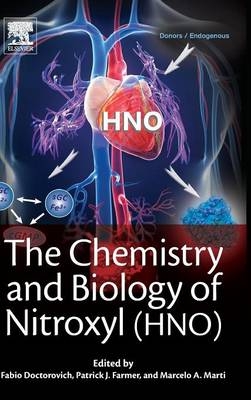
The Chemistry and Biology of Nitroxyl (HNO)
Elsevier Science Publishing Co Inc (Verlag)
978-0-12-800934-5 (ISBN)
This useful resource provides the scientific basis to understand the chemistry, biology, and technical aspects needed to deal with HNO. Building on two decades of nitric oxide and nitroxyl research, the editors and authors have created an indispensable guide for investigators across a wide variety of areas of chemistry (inorganic, organic, organometallic, biochemistry, physical, and analytical); biology (molecular, cellular, physiological, and enzymology); pharmacy; and medicine.
This book begins by exploring the unique molecule’s structure and reactivity, including important reactions with small molecules, thiols, porphyrins, and key proteins, before discussing chemical and biological sources of nitroxyl. Advanced chapters discuss methods for both trapping and detecting nitroxyl by spectroscopy, electrochemistry, and fluorescent inorganic cellular probing.
Expanding on the compound’s foundational chemistry, this book then explores its molecular physiology to offer insight into its biological implications, pharmacological effects, and practical issues.
Prof. Fabio Doctorovich earned his PhD in Organic Chemistry from the University of Buenos Aires (Argentina) in 1990. He was a postdoctoral fellow at the Georgia Institute of Technology working with Prof. E.C. Ashby and K. Barefield, first on single electron transfer and then on chemical reactions taking place in nuclear waste tanks. Back in Argentina, he started to work on nitric oxide (NO), including organic nitrosocompounds, inorganic iron, ruthenium and iridium nitrosyl complexes, and reactivity of metalloporphyrins towards HNO. He also worked on CO complexes, catalytic reactions, and other topics. Nowadays, his research focus is on reactions involving HNO as well as catalytic production of hydrogen from water. Prof. Doctorovich has published over 100 works in international journals such as Accounts of Chemical Research, Journal of the American Chemical Society, Inorganic Chemistry, Journal of Organic Chemistry, and Nature Communications. He has supervised more than 10 PhD students. In 2011, he received the Guggenheim Fellowship. Since 1996, Prof. Doctorovich has been a member of CONICET. Professor and Chair of Chemistry and Biochemistry, Baylor University Dr. Marcelo A. Martí earned his PhD in Biophysical Chemistry from the University of Buenos Aires (Argentina) in 2006 working with Prof. D.A. Estrín and F. Doctorovich. In this period, he pioneered the use of hybrid QM/MM based methods to study metalloprotein reactivity with Reactive Nitrogen and Oxygen Species (RNOS), while performing the first studies on HNO reactions with metallporphyrins. After his PhD, he worked on heme protein Raman spectroscopy in the field of protein electron transfer. In 2010, he accepted a professorship in the Department of Biological Chemistry at the University of Buenos Aires where he leads the protein structure biophysics and bioinformatics group. As a scientist in the triple frontier of chemistry, informatics, and biology, his research is focused on the comprehension of the underlying chemical basis of protein function. This approach has allowed for the construction of a detailed atomic picture of several biological processes, in particular metalloprotein reactions with RNOS. Prof. Martí has published over 100 works in international Journals such as Plos Comp. Biol., J. Am. Chem. Soc., PNAS, and Nat. Comm. He received the Technology Review Argentina Innovators Under 35 Award in 2012, and the Young Scientist Award in Chemistry from the Argentinean National Academy of Sciences in 2013. Since 2008, Dr. Martí has been a member of CONICET.
1. HNO: Redox Chemistry and Interactions With Small Inorganic Molecules
2. HNO Donors: Angeli’s Salt and Related Diazeniumdiolates
3. Hydroxylamines With Organic-Based Leaving Groups as HNO Donors
4. Mechanistic Aspects of HNO Production from Hydroxylamine and Derivatives
5. HNO Generation From NO, Nitrite, Inorganic or Organic Nitrosyls, and Crosstalk With H2S
6. HNO–Thiol Relationship
7. Non-Heme Transition Metal Complexes of HNO
8. The Interaction of HNO With Transition Metal Centers and Its Biological Significance. Insight Into Electronic Structure From Theoretical Calculations
9. Interactions of HNO With Metallated Porphyrins, Corroles, and Corrines
10. Fluorescent Probes for HNO Detection
11. Phosphine-Based HNO Detection
12. Electrochemical Detection of Azanone
13. Detection of HNO by Membrane Inlet Mass Spectrometry
14. Spectroscopic NMR Characterizations of HNO Adducts of Ferrous Heme Proteins
15. Global Kinetic Analysis and Singular Value Decomposition Methods Applied to Complex Multicomponent Reactions of HNO
16. HNO as an Oxygen Substitute in Enzymes
17. The Reactions of HNO With Nonheme Proteins: An Emphasis on Thiol-Containing Proteins
18. Is Azanone Endogenously Produced in Mammals?
19. From Heaven to Heart: Nitroxyl (HNO) in the Cardiovascular System and Beyond
| Erscheinungsdatum | 13.09.2016 |
|---|---|
| Sprache | englisch |
| Maße | 152 x 229 mm |
| Gewicht | 810 g |
| Themenwelt | Naturwissenschaften ► Chemie ► Anorganische Chemie |
| ISBN-10 | 0-12-800934-9 / 0128009349 |
| ISBN-13 | 978-0-12-800934-5 / 9780128009345 |
| Zustand | Neuware |
| Haben Sie eine Frage zum Produkt? |
aus dem Bereich


